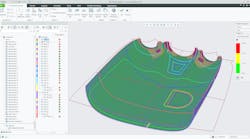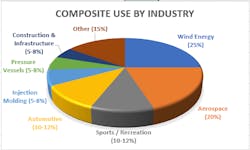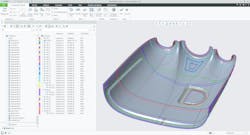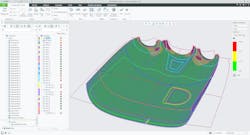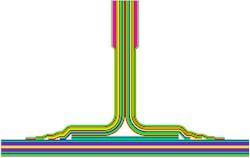Fueled by emerging markets and a growing demand for lightweight-yet-durable materials, the composites industry is a rising economic force. Global demand for composite-based products is growing at an annual clip of nearly 8%. And as this trend continues, the industry is expected to reach $160 billion by 2027.
While this creates a wealth of opportunities for manufacturers across the board, it also exposes product development gaps, compartmentalization and inefficiencies. Composites are a different animal, and traditional tools and processes often leave manufacturers wanting more. Consequently, companies both serving and entering the space are aggressively seeking robust composite-friendly product development technologies to become more streamlined, efficient and integrated across the extended enterprise.
What and Where?
Composites are created by joining thin layers of materials with dissimilar physical and chemical properties to form new material with improved properties and characteristics. These materials fall into four categories—polymer, metal, ceramic and carbon—and make up what are commonly known as fiberglass, carbon fiber and Kevlar.
From a usage perspective, fiberglass dominates the current market, followed by carbon fiber and Kevlar. While these materials are found across nearly all industries, the American Composites Manufacturing Association (ACMA) reports that Wind Energy is the leading consumer (25%) followed by Aerospace (20%), Sporting Goods/Recreation (10-12%), Automotive (10-12%), Compounding for Injection Molded Plastics (5-8%), Pressure Vessels (5-8%), and Construction and Infrastructure (5-8%). Other market segments account for approximately 15%.
While Energy and Aerospace are setting the pace, it is projected that composite demand will grow in all market segments as additional applications and new programs come into production. Agricultural equipment, for example, is one industry that is beginning to find greater uses for composite materials.
Pros and Cons
Composites offer many benefits over metal, plastics and other materials. Key among these is a high strength-to-weight ratio. The material is durable, low-maintenance and offers tremendous design flexibility. In aerospace applications composites make it easy to reduce drag by creating smooth aerodynamic profiles. And because they resist corrosion, composites can exponentially increase the life of marine products such as pressure vessels. Finally, composite materials are generally poor conductors of electricity and heat, making them ideal insulators for parts where insulation is required.
Like all materials, composites have their limitations. And the recent OceanGate tragedy is a stark reminder of this. For example, composites are more brittle and more easily damaged as compared to wrought materials. And because damage isn’t always obvious, as with dented metal, chipped wood or cracked plastic, this can be problematic for products where visual structural inspection is a common maintenance practice.
Finally, some composites are flammable, and the resins they contain release highly toxic fumes when burned. And although largely resistant to heat, structural failure is a possibility at 300°. As a result, some products, applications and industries are not yet conducive to this material.
Product Development
To leverage composite material more effectively into innovative new products the processes must be supported by robust 3D digital technologies. Product Lifecycle Management (PLM) systems maintain an enterprise-wide digital thread throughout the product’s lifecycle. This connectivity ensures that all areas from design, and analysis/simulation, through manufacturing are employing common, accurate and current product data—regardless of where, when or how the model is used or modified throughout the process.
While commonly applied in most traditional product development processes, this comprehensive approach was not readily available to the composites industry. Until now.
Creo for Composites
As processes and materials evolve, CAD/CAM/CAE product design solutions will need to keep pace. In the composites space, PTC’s latest release (Creo 10) fully integrates support for composites allowing users to design, simulate, validate and manufacture composite products without leaving the Creo environment.
Vice President of Product Management Paul Sagar explained that while Creo provides enhanced and new functionality to users across the board, there’s no denying that a significant part of development is in response to the needs of a growing market.
“To take advantage of material stiffness, weight, strength and impact absorption, more of our customers are building products that are composite in nature,” said Sagar. “In the past this meant moving in and out of design, analysis and manufacturing systems. This not only creates unnecessary delays, but just as importantly it breaks the seamless connection between design tools and the digital thread. In speaking with our customers, we knew that this was something that had to be addressed.”
READ MORE: Q&A: Design for Electrification, Design for Ergonomics and New Analysis Tools
Creating an integrated product development environment for composites was the result of years of research and development…and came with its share of challenges.
“With traditional materials the part is the final geometry. But this isn’t the case in a composite where that part is comprised of multiple layers,” said Sagar. “How do you define a thousand individual pieces, track those thousand pieces, manage all the interdependencies and references between those thousand individual pieces? Needless to say, building the infrastructure to support this was a particular challenge.”
Technology was another consideration. Providing functionality unique to composites manufacturing, such as draping, meant developing or acquiring new tools and integrating them seamlessly into the Creo environment.
“Fabric is draped to form the shape and when stretched this puts a shear strain on the fabric. Companies must be able to understand and simulate this to determine if a certain fabric can form a certain shape. If not, they have to be able to explore options to determine how to get around it. Once you’ve draped it the same algorithm essentially is used to flatten the design so the fabric can be cut. These are just a couple of challenges we had to overcome.”
Composite Design
Composites allow designers to marry light-weighting with high strength to carry demanding loads. The process involves adding layers of materials to create nearly limitless shapes, intricate forms and a wide range of densities. While this opens the door to a magnitude of innovative options, it also creates challenges not found with traditional materials. The key is geometric accuracy and the ability to easily verify material builds on the fly.
In Creo 10, PTC introduced a broad set of powerful capabilities to make designing with composites flexible while allowing changes to be made easily. While other software systems are making assumptions, Creo leverages draping technology to accurately calculate mass properties. The result is a more realistic, and more precise, representation of the final design.
Creo incorporates simulation-driven design methodology. In this way, designers can perform simulations to quickly check models as they are being constructed to verify that layering achieves the desired effect. This drives innovation and optimization through an uninterrupted design process and the exploration of layer material, orientation and thickness options.
Creo also helps users navigate the waters with process workflow, design, material selection, laminate sections, ply transitions, inner mold lines and so on. Having access to both a feature list and a ply list are especially significant to composites manufacturing.
Composite Simulation
Companies approach simulation in many ways and PTC offers several options. While designers can perform some quick high-level simulations, CAE analysts utilize Creo’s robust simulation package to take a deeper dive to examine and simulate the model for final validation.
Creo simulation users can access the mass properties of composite parts created in the design stage and perform structural analysis of these complex parts, taking into account each ply’s material characteristics and orientation, ensuring that the final parts meet the engineering requirements. Users can employ the software’s Draping Simulation feature to analyze the ply producibility and create the ply flat patterns.
READ MORE: Achieving Complex Geometries in 3D Printing
Creo calculates the fiber distortion while simulating the application of the flat ply onto the mold. By default, draping is calculated by considering all underlying plies. This makes the results more accurate and realistic and provides insight into the fiber distortion, enabling users to optimize the selected seed point location and draping direction to get the best possible result.
All of this is done inside Creo without exporting/importing the model. However, companies choosing to employ a third-party simulation package can access rich definition and export it to an analyst tool of their choice.
Composite Manufacturing
When it comes to manufacturing and assembly, composites generally offer time and cost savings over traditional metals. Composite parts can be combined into a single component to reduce assembly costs. Also, inserts can be molded directly into the part during the molding process, thereby reducing the need for post-process changes.
Still, manufacturing composites comes with its challenges as fabric must be precisely cut, oriented/layered and cured. To ensure manufacturability, the model is inspected by the manufacturing engineer using Creo to verify that it meets all required specifications. If not, the engineer is alerted to problem areas. For example, it may be that the validated design contains plies that are wider than the roll of fabric. How can this be addressed without adversely affecting the model?
READ MORE: Replacement Parts are a 3D Print Away
According to Creo Product Manager Arnaud Van de Veerdonk this is easily done. “The manufacturing engineer can open the model and determine changes to make the design manufacturable. Do I need to split the ply into multiple pieces? How big should these pieces be and how am I going to overlap them? Using the Creo splicing tool, the engineer can splice or cut that ply into two or more pieces so that it can be cut and manufactured correctly.”
And just as the designer can run quick simulations, Creo allows the manufacturing engineer to do the same. Of course, the engineer must then ensure that changes will not change the intent of the design or impact its structural integrity.
The Bottom Line
Each year the composites industry contributes more than $22 billion to the U.S. economy alone. And the call for lighter, more efficient and sustainable transportation, energy and industrial solutions will continue to push demand even higher. For manufacturers serving these and emerging industries, this requires adopting a fully integrated arsenal of composites-friendly technologies.
With current solutions, departments throughout the extended enterprise can work with a common model, perform simulations, make design changes and leverage accurate product data—all without importing and exporting the model. A single thread starts at design and runs through manufacturing. This is the digital thread in action.
“A lot of companies that work with composites are forced to cut corners in the design stage because the software isn’t capable of managing and building accurate information,” said Sagar. “For example, they can’t get accurate mass properties of how much a part accurately weighs when it’s finished because their system doesn’t accurately calculate it. Accuracy is something that PTC has always taken pride in. Everything we create is accurate, real and true. In the end that’s quite a big differentiator for us.”
Robert Farrell is the owner of Farrell MarCom, LLC and co-founder of Revolution in Simulation.
